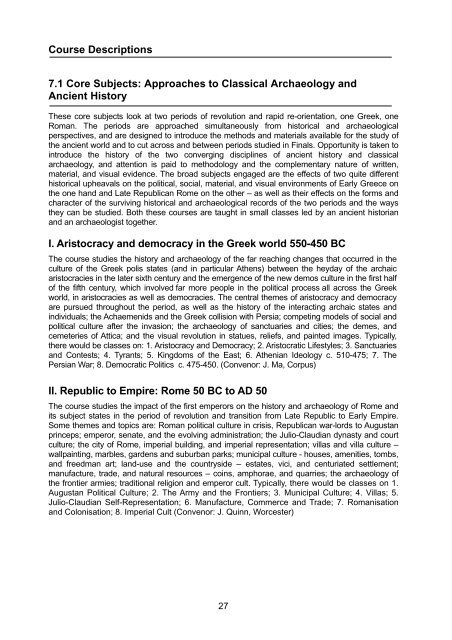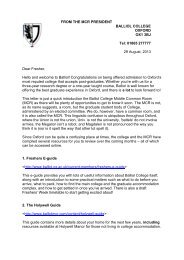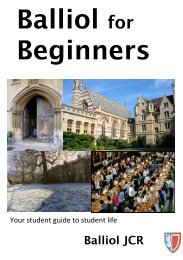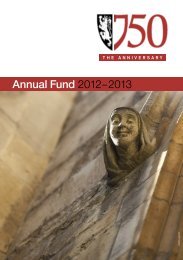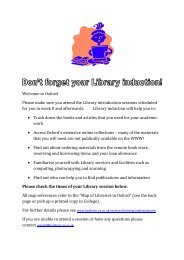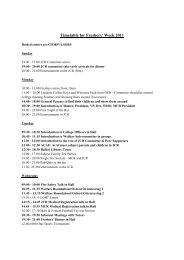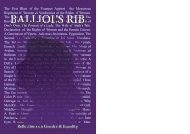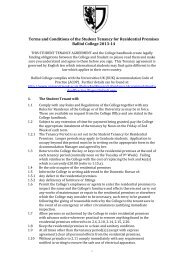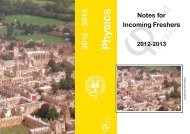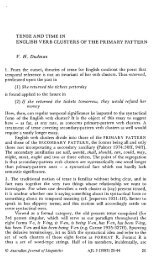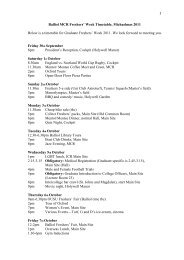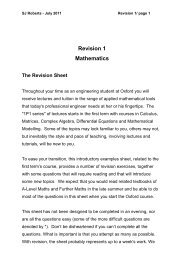CAAH Mods 2011 - Balliol College - University of Oxford
CAAH Mods 2011 - Balliol College - University of Oxford
CAAH Mods 2011 - Balliol College - University of Oxford
Create successful ePaper yourself
Turn your PDF publications into a flip-book with our unique Google optimized e-Paper software.
Course Descriptions<br />
7.1 Core Subjects: Approaches to Classical Archaeology and<br />
Ancient History<br />
These core subjects look at two periods <strong>of</strong> revolution and rapid re-orientation, one Greek, one<br />
Roman. The periods are approached simultaneously from historical and archaeological<br />
perspectives, and are designed to introduce the methods and materials available for the study <strong>of</strong><br />
the ancient world and to cut across and between periods studied in Finals. Opportunity is taken to<br />
introduce the history <strong>of</strong> the two converging disciplines <strong>of</strong> ancient history and classical<br />
archaeology, and attention is paid to methodology and the complementary nature <strong>of</strong> written,<br />
material, and visual evidence. The broad subjects engaged are the effects <strong>of</strong> two quite different<br />
historical upheavals on the political, social, material, and visual environments <strong>of</strong> Early Greece on<br />
the one hand and Late Republican Rome on the other – as well as their effects on the forms and<br />
character <strong>of</strong> the surviving historical and archaeological records <strong>of</strong> the two periods and the ways<br />
they can be studied. Both these courses are taught in small classes led by an ancient historian<br />
and an archaeologist together.<br />
I. Aristocracy and democracy in the Greek world 550-450 BC<br />
The course studies the history and archaeology <strong>of</strong> the far reaching changes that occurred in the<br />
culture <strong>of</strong> the Greek polis states (and in particular Athens) between the heyday <strong>of</strong> the archaic<br />
aristocracies in the later sixth century and the emergence <strong>of</strong> the new demos culture in the first half<br />
<strong>of</strong> the fifth century, which involved far more people in the political process all across the Greek<br />
world, in aristocracies as well as democracies. The central themes <strong>of</strong> aristocracy and democracy<br />
are pursued throughout the period, as well as the history <strong>of</strong> the interacting archaic states and<br />
individuals; the Achaemenids and the Greek collision with Persia; competing models <strong>of</strong> social and<br />
political culture after the invasion; the archaeology <strong>of</strong> sanctuaries and cities; the demes, and<br />
cemeteries <strong>of</strong> Attica; and the visual revolution in statues, reliefs, and painted images. Typically,<br />
there would be classes on: 1. Aristocracy and Democracy; 2. Aristocratic Lifestyles; 3. Sanctuaries<br />
and Contests; 4. Tyrants; 5. Kingdoms <strong>of</strong> the East; 6. Athenian Ideology c. 510-475; 7. The<br />
Persian War; 8. Democratic Politics c. 475-450. (Convenor: J. Ma, Corpus)<br />
II. Republic to Empire: Rome 50 BC to AD 50<br />
The course studies the impact <strong>of</strong> the first emperors on the history and archaeology <strong>of</strong> Rome and<br />
its subject states in the period <strong>of</strong> revolution and transition from Late Republic to Early Empire.<br />
Some themes and topics are: Roman political culture in crisis, Republican war-lords to Augustan<br />
princeps; emperor, senate, and the evolving administration; the Julio-Claudian dynasty and court<br />
culture; the city <strong>of</strong> Rome, imperial building, and imperial representation; villas and villa culture –<br />
wallpainting, marbles, gardens and suburban parks; municipal culture - houses, amenities, tombs,<br />
and freedman art; land-use and the countryside – estates, vici, and centuriated settlement;<br />
manufacture, trade, and natural resources – coins, amphorae, and quarries; the archaeology <strong>of</strong><br />
the frontier armies; traditional religion and emperor cult. Typically, there would be classes on 1.<br />
Augustan Political Culture; 2. The Army and the Frontiers; 3. Municipal Culture; 4. Villas; 5.<br />
Julio-Claudian Self-Representation; 6. Manufacture, Commerce and Trade; 7. Romanisation<br />
and Colonisation; 8. Imperial Cult (Convenor: J. Quinn, Worcester)<br />
27


